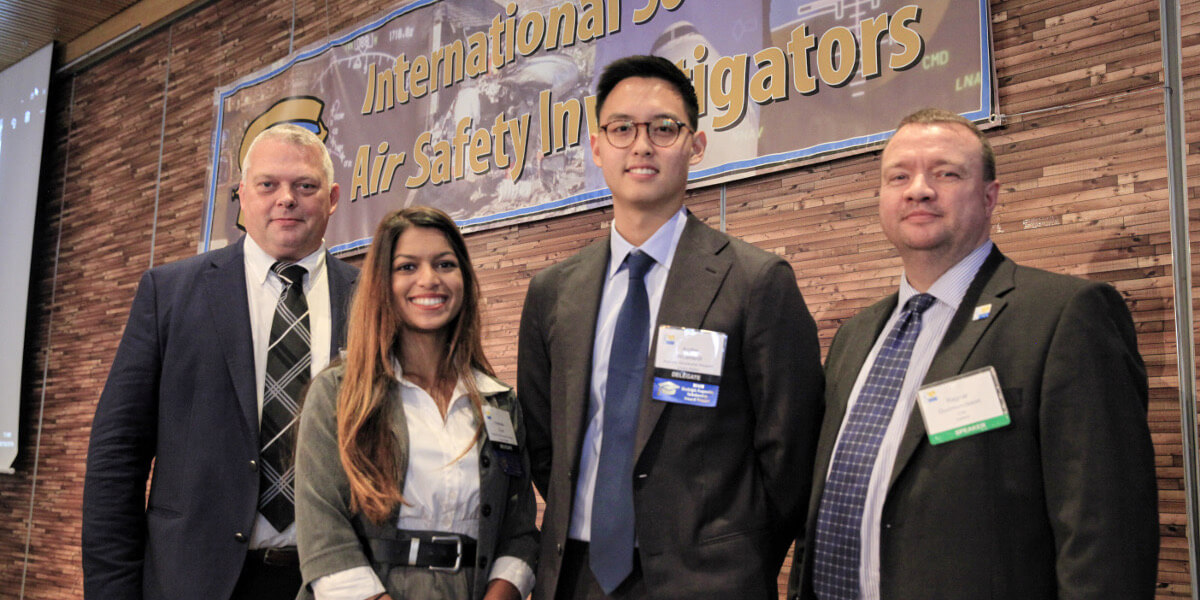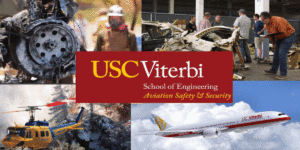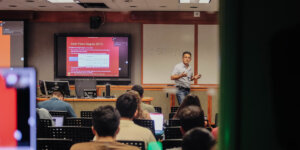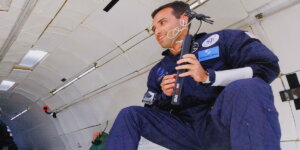
Yasmeen Syed (2nd from left) and Andre Woenardi (3rd from left) at the ISASI Annual Conference 2016 in Reykjavik, Iceland this October. Photo courtesy of ISASI
Last spring, Yasmeen Syed and Andre Woenardi had no idea their “Human Factors in Work Design” class would land them on international shores come fall.
This October, the pair travelled to Reykjavik, Iceland to accept the International Society of Air Safety Investigator (ISASI) 2016 Kasputin Scholarship Award for their class term paper on aviation safety called “Air Asia 8501: Echoes of Air France 447.”
The students, both undergraduates in the USC Daniel J. Epstein Department of Industrial and Systems Engineering, chose Air France 447 as a comparative study for its similarities to Air Asia 8501, a flight in 2014 that crashed into the Java Sea off the coast of Indonesia, killing all 155 passengers and seven crew members on board. In 2009, Air France 447 crashed into the Atlantic Ocean off the coast of Brazil, killing all 228 passengers and crew.
Their joint research on Air Asia 8501 came about organically. Woenardi, a senior and native Indonesian, wanted to write something closely related to his home country. Syed, a junior who loves to study accident investigation, was introduced to the subject by the course’s instructor, Professor Najmedin Meshkati of the USC Viterbi School of Engineering.
“One of the things we focused on in the paper is that pilots rely so heavily on automation these days,” Syed said. “So, because of that, in the case of emergency or in the face of adversity, they’re not able to manually operate the aircraft. And that’s what happened in both accidents.”
In both cases, the aircrafts encountered an “aerodynamic stall,” in which the plane’s angle of attack is too high, with not enough air going over the wings. This causes the plane to drop significantly in altitude, almost like it’s dropping out of the sky. If aware of a stall, a pilot could manually recover by dipping the plane’s nose into a dive and eventually level out.
Unfortunately, neither pilot realized they were stalling in the first place. Both had lost “situational awareness,” Syed explained. And for both crashes, technical error wasn’t the only cause. It was pilot error that followed a technical failure.
“When you don’t know what the problem is, how can you fix it?” Syed said. “They didn’t know where they were relative in the sky. For whatever reason, they thought to continue going upwards, which eventually led to the accident.”
Guided by Meshkati, Syed and Woenardi worked closely with USC Aviation Safety and Security and received feedback from Douglas Moss, a United Airlines pilot who consults for an accident investigation company.
Moss had explained to them that, due to advancement in cockpit automation, pilot training has actually been reduced in time and scope. He made the case that training should actually be lengthened because of this advanced technology and human error in operating with or without it, as in the case of deactivation mid-flight.
“In both of these accidents, the pilot flying was the first officer instead of the captain who would have had more hours flying, more experience,” Woenardi said.
Syed added that in both cases most of the pilot’s experience consisted of flying automated planes. Even with dual input from the captain in Air Asia 8501, the captain and first officer were pulling in opposite directions on manual equipment which neutralized instead of corrected the technical failure.
For their award, Syed and Woenardi received $2,000 each, which covered flight, hotel and conference expenses. While in Iceland, they visited glaciers, hiked to waterfalls, swam in hot springs and presented their research to an audience of aviation experts from all over the world.
“In terms of research, I think the biggest thing I learned, that I was very unaware of, is what you have to say about certain subject matters will always have critique,” Woenardi said. “Not everyone will agree with the things you say, and I’m not sure the best way to handle it.”
“Alternatively, we did have an investigator who was directly involved with Air Asia 8501 thank us tremendously for our research,” Syed said. “The experience was so transformative and incredible. I feel like I learned so much and formed such great connections, so that scholarship is probably one of the best things that’s happened to me in my life.”
To read the students’ awarded paper, go here: http://www.isasi.org/Awards/isasi-scholarship-winners.aspx
Published on November 30th, 2016
Last updated on May 13th, 2023












